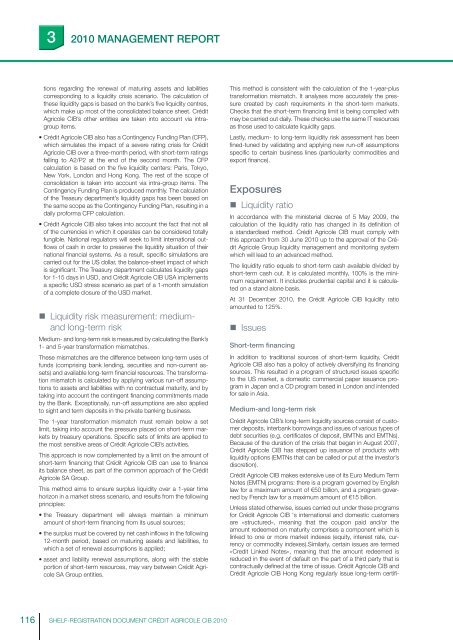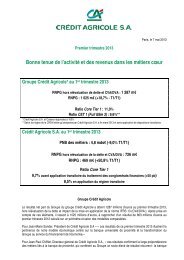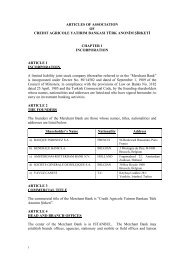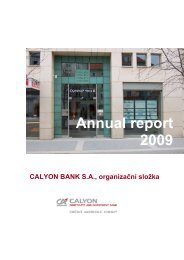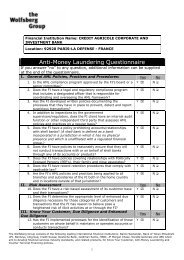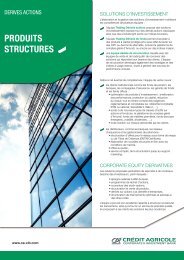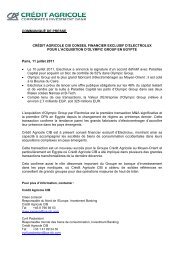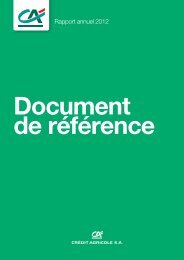ourexpertise - Crédit Agricole CIB
ourexpertise - Crédit Agricole CIB
ourexpertise - Crédit Agricole CIB
You also want an ePaper? Increase the reach of your titles
YUMPU automatically turns print PDFs into web optimized ePapers that Google loves.
32010 MANAGEMENT REPORTtions regarding the renewal of maturing assets and liabilitiescorresponding to a liquidity crisis scenario. The calculation ofthese liquidity gaps is based on the bank’s fi ve liquidity centres,which make up most of the consolidated balance sheet. <strong>Crédit</strong><strong>Agricole</strong> <strong>CIB</strong>’s other entities are taken into account via intragroupitems.• <strong>Crédit</strong> <strong>Agricole</strong> <strong>CIB</strong> also has a Contingency Funding Plan (CFP),which simulates the impact of a severe rating crisis for <strong>Crédit</strong><strong>Agricole</strong> <strong>CIB</strong> over a three-month period, with short-term ratingsfalling to A2/P2 at the end of the second month. The CFPcalculation is based on the fi ve liquidity centers: Paris, Tokyo,New York, London and Hong Kong. The rest of the scope ofconsolidation is taken into account via intra-group items. TheContingency Funding Plan is produced monthly. The calculationof the Treasury department’s liquidity gaps has been based onthe same scope as the Contingency Funding Plan, resulting in adaily proforma CFP calculation.• <strong>Crédit</strong> <strong>Agricole</strong> <strong>CIB</strong> also takes into account the fact that not allof the currencies in which it operates can be considered totallyfungible. National regulators will seek to limit international outflows of cash in order to preserve the liquidity situation of theirnational fi nancial systems. As a result, specifi c simulations arecarried out for the US dollar, the balance-sheet impact of whichis signifi cant. The Treasury department calculates liquidity gapsfor 1-15 days in USD, and <strong>Crédit</strong> <strong>Agricole</strong> <strong>CIB</strong> USA implementsa specifi c USD stress scenario as part of a 1-month simulationof a complete closure of the USD market.• Liquidity risk measurement: mediumandlong-term riskMedium- and long-term risk is measured by calculating the Bank’s1- and 5-year transformation mismatches.These mismatches are the difference between long-term uses offunds (comprising bank lending, securities and non-current assets)and available long-term fi nancial resources. The transformationmismatch is calculated by applying various run-off assumptionsto assets and liabilities with no contractual maturity, and bytaking into account the contingent fi nancing commitments madeby the Bank. Exceptionally, run-off assumptions are also appliedto sight and term deposits in the private banking business.The 1-year transformation mismatch must remain below a setlimit, taking into account the pressure placed on short-term marketsby treasury operations. Specifi c sets of limits are applied tothe most sensitive areas of <strong>Crédit</strong> <strong>Agricole</strong> <strong>CIB</strong>’s activities.This approach is now complemented by a limit on the amount ofshort-term fi nancing that <strong>Crédit</strong> <strong>Agricole</strong> <strong>CIB</strong> can use to fi nanceits balance sheet, as part of the common approach of the <strong>Crédit</strong><strong>Agricole</strong> SA Group.This method aims to ensure surplus liquidity over a 1-year timehorizon in a market stress scenario, and results from the followingprinciples:• the Treasury department will always maintain a minimumamount of short-term fi nancing from its usual sources;• the surplus must be covered by net cash infl ows in the following12-month period, based on maturing assets and liabilities, towhich a set of renewal assumptions is applied;• asset and liability renewal assumptions, along with the stableportion of short-term resources, may vary between <strong>Crédit</strong> <strong>Agricole</strong>SA Group entities.This method is consistent with the calculation of the 1-year-plustransformation mismatch. It analyses more accurately the pressurecreated by cash requirements in the short-term markets.Checks that the short-term fi nancing limit is being complied withmay be carried out daily. These checks use the same IT resourcesas those used to calculate liquidity gaps.Lastly, medium- to long-term liquidity risk assessment has beenfi ned-tuned by validating and applying new run-off assumptionsspecifi c to certain business lines (particularity commodities andexport fi nance).Exposures• Liquidity ratioIn accordance with the ministerial decree of 5 May 2009, thecalculation of the liquidity ratio has changed in its defi nition ofa standardised method. <strong>Crédit</strong> <strong>Agricole</strong> <strong>CIB</strong> must comply withthis approach from 30 June 2010 up to the approval of the <strong>Crédit</strong><strong>Agricole</strong> Group liquidity management and monitoring systemwhich will lead to an advanced method.The liquidity ratio equals to short-term cash available divided byshort-term cash out. It is calculated monthly, 100% is the minimumrequirement. It includes prudential capital and it is calculatedon a stand alone basis.At 31 December 2010, the <strong>Crédit</strong> <strong>Agricole</strong> <strong>CIB</strong> liquidity ratioamounted to 125%.• IssuesShort-term financingIn addition to traditional sources of short-term liquidity, <strong>Crédit</strong><strong>Agricole</strong> <strong>CIB</strong> also has a policy of actively diversifying its fi nancingsources. This resulted in a program of structured issues specifi cto the US market, a domestic commercial paper issuance programin Japan and a CD program based in London and intendedfor sale in Asia.Medium-and long-term risk<strong>Crédit</strong> <strong>Agricole</strong> <strong>CIB</strong>’s long-term liquidity sources consist of customerdeposits, interbank borrowings and issues of various types ofdebt securities (e.g. certifi cates of deposit, BMTNs and EMTNs).Because of the duration of the crisis that began in August 2007,<strong>Crédit</strong> <strong>Agricole</strong> <strong>CIB</strong> has stepped up issuance of products withliquidity options (EMTNs that can be called or put at the investor’sdiscretion).<strong>Crédit</strong> <strong>Agricole</strong> <strong>CIB</strong> makes extensive use of its Euro Medium TermNotes (EMTN) programs: there is a program governed by Englishlaw for a maximum amount of €50 billion, and a program governedby French law for a maximum amount of €15 billion.Unless stated otherwise, issues carried out under these programsfor <strong>Crédit</strong> <strong>Agricole</strong> <strong>CIB</strong> ‘s international and domestic customersare « structured«, meaning that the coupon paid and/or theamount redeemed on maturity comprises a component which islinked to one or more market indexes (equity, interest rate, currencyor commodity indexes).Similarly, certain issues are termed« Credit Linked Notes«, meaning that the amount redeemed isreduced in the event of default on the part of a third party that iscontractually defi ned at the time of issue. <strong>Crédit</strong> <strong>Agricole</strong> <strong>CIB</strong> and<strong>Crédit</strong> <strong>Agricole</strong> <strong>CIB</strong> Hong Kong regularly issue long-term certifi -116SHELF-REGISTRATION DOCUMENT CRÉDIT AGRICOLE <strong>CIB</strong> 2010


